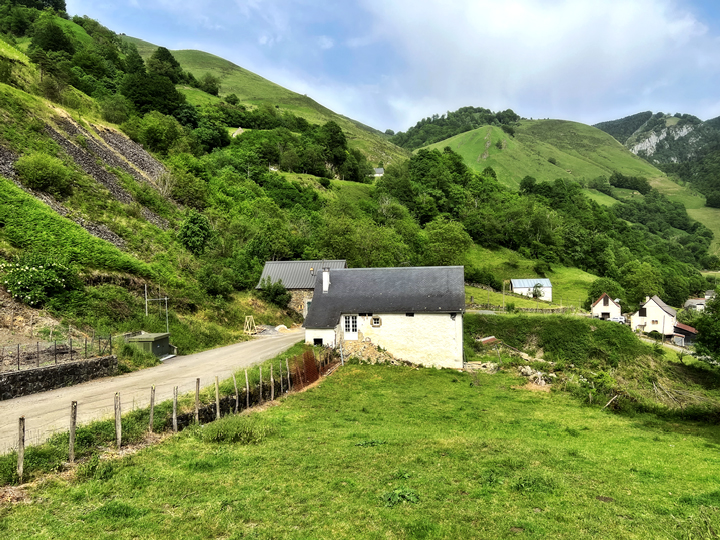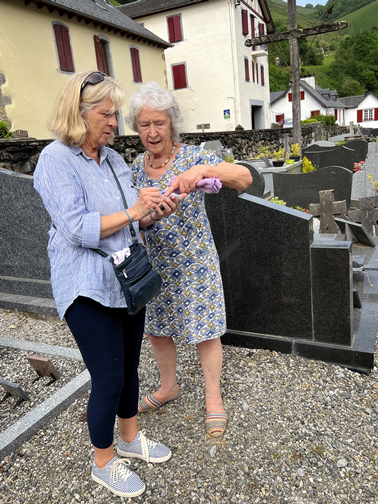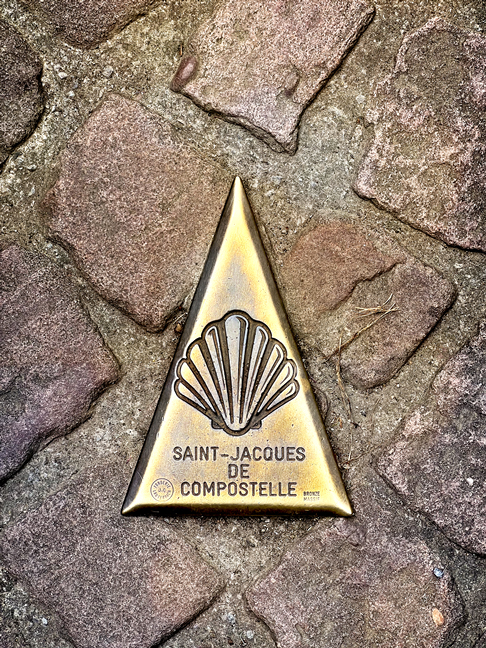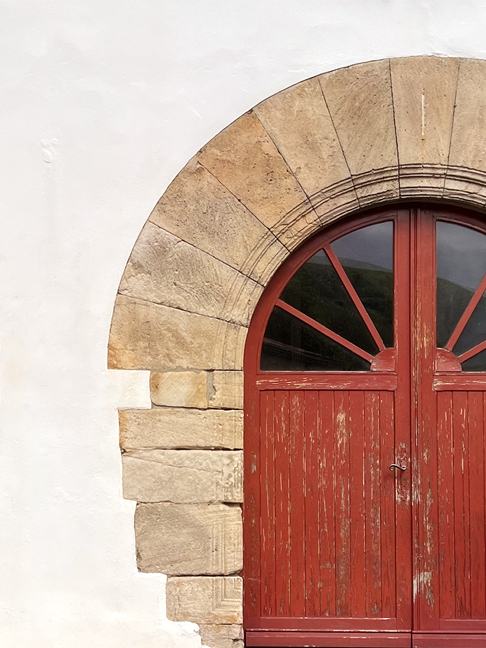
That was then…
Twenty-seven years ago, I set off from my home in California and paid a visit to my friends Mindy and John, who were living near Paris at the time. Part of the vacation involved Mindy and me taking a road trip, with our first stop landing us in Saint-Émilion. Wine and hilarity ensued, but that’s a story for another day. We continued south, passing through Auch long enough for each of us to air-kiss a giant statue of D’Artagnan, and then we continued toward the towering Pyrenees, where we explored towns and hiked and thoroughly enjoyed ourselves.
One thing that I wanted to do on that trip was to visit the area around Tardets, because I had read Robert Laxalt’s book Sweet Promised Land, a splendid narrative about one emigrant, the place he left behind, and the rare opportunity to return “home.” Laxalt wrote a whole series of books about the Basque people, his father’s ancestral home, and the Basque immigrant experience in the western United States, and I eagerly read them all.
I was hoping to find someone who could talk to me about the Laxalt family, whom I had known growing up in Reno. It was raining hard the day we decided to try our luck, and the place we chose to stop and ask questions was a bar called the Calamity Jane Saloon. (I do not remember how we chose this place.) The café was decorated with studio shots of the Hollywood cowboys: John Wayne, Steve McQueen, Gregory Peck. They were all there, every last one of them giving me a steely-eyed stare while I stumbled through a question in my nearly-useless French. I happened to be asking the only other person in the joint, a pouting young woman who barely summoned the energy to convey that she had no interest in my question.
We left with no answers, and continued driving, climbing high enough to find that it had snowed the day before. It was late spring, and everything was a rich, saturated green, newly blanketed with fresh white snow. It was a striking image, a postcard-perfect backdrop for the village we eventually found, Sainte-Engrâce. This was not a town that was used to seeing many outsiders, and we were noticed, although no one spoke to us. We visited the medieval church, looked around a bit, and then left the village behind, marking the end of that particular chapter.

And this is now (day one)
Fast forward to 2022: my friend Katie was visiting me in France, and we decided to spend a few days in the area around Saint-Jean-Pied-de-Port before I dropped her off with friends near Pau. We had a little trouble finding accommodation, and ended up with reservations at a chambres-d’hôtes (bed and breakfast) in the village of Saint-Étienne-de-Baïgorry.
But before going there, we did something I’ve long wanted to do: return to Sainte-Engrâce to see that church, because in the intervening years, I’ve learned more about medieval architecture, and it has become a favorite.
The foothills and river valleys of the Pyrenees had already given us a clue: it was absolutely as green as I remembered it. Luxuriant with trees and bushes and grasses, the variety of green hues was astounding. As we climbed higher, the terrain became very steep and rocky, but the green remained so vibrant that it didn’t quite seem real. We both marveled at the rock formations, and imagined the fabulous hiking to be done there.

We spotted a pigeonnier (a tower-like structure for keeping pigeons), saw a few farmhouses, and passed a lot of signs offering fromage de brebis (sheep’s milk cheese). I took note; I’m willing to travel far for a good Basque sheep’s milk cheese.
At every turn, a new vista, enchanting and wild and green. We made a few turns through the village and arrived at the church, an 11th-century wonder said to have been originally built at the foot of an ancient oak tree. Inside, I made photos of the remarkable column capitals, still with their original paint. Outside, the churchyard holds some of the intriguing discoidal grave markers found in this region.



There were a few people in the churchyard, carrying flats of flowers to plant. One couple was visiting graves of family members; when the woman turned to leave, her purse was snagged by a stone cross. I remarked that now she would have to stay here; she liked the humor in that and we began a brief chat. We were interrupted, though, when she recognized one of the people planting flowers and shouted his name.
“Félix!” A man looked up, surprised, and she rushed over to him to ask if he didn’t recognize her. They’d gone to school together, and perhaps had not seen each other since.
While they had a miniature 60-year class reunion right there next to all those graves, Katie and I turned to move along, but we stopped to speak with two women. One of them mentioned that the other had a great-great-grandfather who had carried a large stone on his back to place as the step leading into the church. I can attest to the man’s strength: it’s a really large slab of rock. We continued the conversation with the first woman, whose name is Marcelle. She was intrigued to learn that I had visited once before, and that I’d grown up among Basques in Nevada. She mentioned an American woman who had come to Sainte-Engrâce many, many years before to study and write a book, and then she dropped her bombshell. “She’s now teaching at the University of Nevada.”
Well, when you grow up in Reno, it’s hard not to know someone affiliated with the University, and I’ve known quite a few. Marcelle—who turns out to be Félix’s sister—kept telling us more stories, and gave me a name to look up. I was intrigued and intended to see where this path might lead, perhaps even purchasing the book this woman had written about the people of Santazi.


We reluctantly said our good-byes to these lovely people and continued on our way, stopping for a few photos and then climbing higher to a remote and very curvy pass. As we climbed, the sky began to cloud over and it looked like rain was headed our way. This drive was remote and wild—and green!—and soon we had high winds, quickly followed by rain lashing the car. After the summit, we dropped down into a different world, as the road became somewhat more tame and wound its way through a forest.

We began to see some farmhouses, a ski station, a campground, and then villages. We drove into Saint-Jean-Pied-de-Port in search of dinner, which we found, and afterward we drove on to Saint-Étienne-de-Baïgorry. My phone navigated us straight to the house that we’d call home for two nights, happily situated on the edge of town and overlooking the dramatic hills of the region.
Our hostess, Marjorie, greeted us with a welcoming smile and showed us to our lovely rooms. It was the end of a full day, and we were both happy to settle in for a quiet evening and a good night’s sleep.
One last thing
Before I turned off the light, though, I thought I’d see if I could find this author/professor who’d won the hearts of the people in Sainte-Engrâce. In no time at all, I found her: Professor Sandra Ott of the Basque Studies program at the University of Nevada. She’s written a lot, but the book in question is The Circle of Mountains.
Two days later, and back in my home, I wrote to Professor Ott, explaining a little of who I am, and my interest in the Pays Basque. I told her that I’d like to order a copy of her book, and perhaps find a way to have her sign it for me.
The next day, she wrote back, a note of astonishment coming through the digital words. She was writing from an airport, waiting to catch her flight to Pau; she would be doing research in the Pays Basque and her beloved Santazi for over a month. And she’d be happy to sign a book to me. What a wonderful, small world!

Day two
The next day we had a couple of things to do, but our first order of business was to walk across the little valley to Marjorie’s “neighbor” to buy six-month aged Basque sheep’s milk cheese. There are a lot of different Basque cheeses, but my very favorite is called Ossau-Iraty, and this is its home turf. If Marjorie says it’s good, then I trust her, and Katie and I happily set off for the farm.
We met Michel, one member of the Tambourin family, who interrupted his milking duties to sell us some cheese, along with its great companion, black cherry preserves. Yum! He also gave us directions for what is surely a splendid local hike, which we didn’t have time for, but it’s on my list for the next visit.


We took a little drive to a nearby town to check out a Basque-run furniture business that I was curious about, and then we turned our sights toward Saint-Jean-Pied-de-Port. It was time for lunch and a little exploring.
Saint-Jean is one of the traditional starting points for many of the people who are walking the ancient pilgrim route to Santiago de Compostella, so it tends to be full of folks with sturdy backpacks and walking sticks. It’s a picturesque and historic town, with plenty to explore.
The original town, a few kilometers away, was destroyed by Richard Lionheart in 1177, and shortly after that, it was rebuilt in its current location on the River Nive. The three main French routes for the Way of Saint James, which start in Paris, Vézelay, and Le-Puy-en-Velay, all meet at Saint-Jean-Pied-de-Port, which marks the traditional route over the Pyrenees and into Spain. “Pied-de-Port” means “foot of the pass,” referring to the Roncevaux Pass over the mountains.
After a few hours of poking around town, we turned our attention to Saint-Étienne, where we were staying, about 15 minutes down the road. We thought we’d have a quick look around and then return to our lodging for a little rest before dinner.




Day three
After another good night’s sleep, we went down to breakfast to find that we had Marjorie all to ourselves. The three of us enjoyed a lively conversation, and I related the story of searching for the roots of the Laxalt family. Marjorie frowned and said that the name Laxalt did not come from this area, but rather from Tardets, an hour’s drive to the east.
I pulled out my phone and did a little search, finding some information about Thérèse Alpetche Laxalt, the matriarch of the Nevada family. When I spoke her birth name aloud, Marjorie exclaimed and practically shouted that the name Alpetche comes from the Germiette quarter of this very town—Saint-Étienne-de-Baïgorry—and that you can see the neighborhood from her window. We walked to the front door and looked across the valley to a cluster of houses; Marjorie said, “That’s where Thérèse was born.” A fun discovery!
I went upstairs to brush my teeth, and I could hear Marjorie speaking excitedly on the phone. When I returned downstairs, I saw Katie and Marjorie in the kitchen, talking to a man who stood outside the kitchen window. The neighbor had sent her husband over to meet us and hear the story. His name is Jean-Michel, a soft-spoken man with a gentle smile and a twinkle in his eye. It’s the same fellow that Katie had photographed the day before, herding his sheep.
We reluctantly parted ways, promising to share a glass of wine and more stories the next time I’m in the Pays Basque.


New discoveries: Bed and Breakfast
Maison Amestoïa
We only had two nights to stay in Le Pays Basque (Basque Country), but it was the start of the high season, both for tourism and for pilgrims on the Way of St. James. We had a little trouble finding accommodation, and we took the only thing that was available: a chambres-d’hôtes (bed and breakfast) in a town not far from where we wanted to be. We didn’t really know what to expect, but neither of us expected the fantastic experience we had at Maison Amestoïa.
We were greeted by Marjorie, who instantly had us feeling like old friends. Her warm smile and enthusiastic welcome put us right at ease, and she showed us to our rooms. We had arrived after dinner, near the end of a full day, and we quickly gave in to the temptation offered by the quiet, tastefully-decorated rooms with their cozy beds.

The next morning we went to the kitchen for a delicious full breakfast, and enjoyed conversation with Marjorie and the other two guests, a couple who were walking the GR10 along the Pyrenees, going from the Atlantic to the Mediterranean.
As I mentioned above, Marjorie sent us over to visit her neighbor across the valley to buy a chunk of his delicious Ossau-Iraty cheese and a jar of the black cherry preserves that traditionally accompany this cheese. She also pointed us to a few restaurant options for lunch and for dinner, as well as some shops for purchasing traditional Basque crafts such as espadrilles and the region’s famous striped cotton fabric.
Alas, our stay in the area was too short to allow much time to enjoy Marjorie’s garden and view. I can easily picture sitting on the terrace with a glass of wine and my thoughts, gazing out at the lovely valley. I’ll be returning to Maison Amestoïa.
If you plan to be in the Pays Basque in southwestern France, this would be a great central location for your explorations. Saint-Étienne-de-Baïgorry is about 1.5 hours from San Sebastién in Spain, and an hour from Bayonne, giving the visitor easy access to both mountains and the sea. To make reservations or learn more, please contact Marjorie directly at +33 (0)5 59 37 67 70.




The Basque countryside is breathtaking! And such a great story to along with it.
Thanks for passing along the tip about the preserves with the cheese, although the Ossau Iraty has been difficult to come by recently.
LikeLike
Thanks for writing, Adrienne! Yes, the badly-researched and misguided American dairy laws have now found their way to the EU, and the Basque cheeses seem to be the first to suffer. I’ve had trouble finding raw Ossau-Iraty, and there seems to be a ripple effect. Dang.
LikeLike